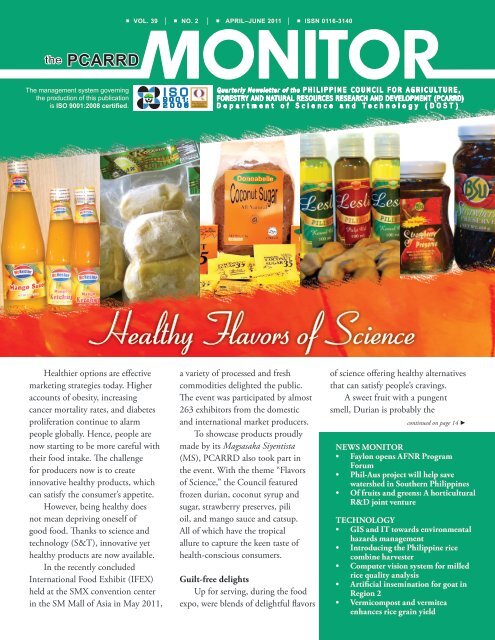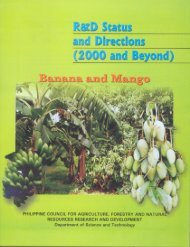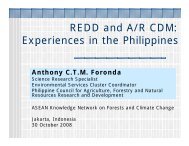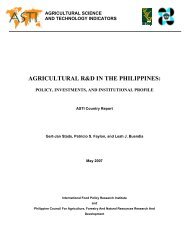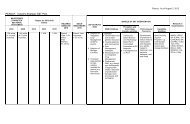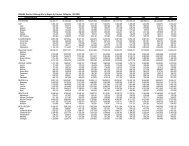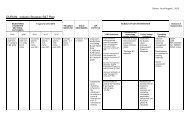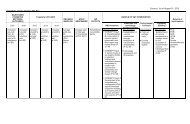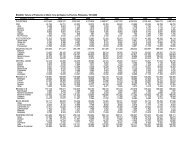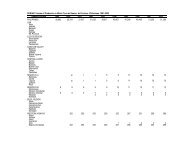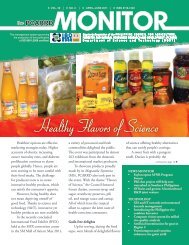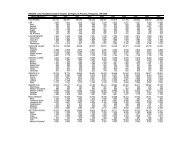Healthy Flavors of Science - pcaarrd - Department of Science and ...
Healthy Flavors of Science - pcaarrd - Department of Science and ...
Healthy Flavors of Science - pcaarrd - Department of Science and ...
Create successful ePaper yourself
Turn your PDF publications into a flip-book with our unique Google optimized e-Paper software.
■ Vol. 39 │ ■ No. 2 │ ■ APRIL–JUNE 2011 │ ■ ISSN 0116-3140<br />
the PCARRD<br />
The management system governing<br />
the production <strong>of</strong> this publication<br />
is ISO 9001:2008 certified.<br />
ISO<br />
9001:<br />
2008<br />
Quarterly Newsletter <strong>of</strong> the PHILIPPINE COUNCIL FOR AGRICULTURE,<br />
FORESTRY AND NATURAL RESOURCES RESEARCH AND DEVELOPMENT (PCARRD)<br />
<strong>Department</strong> <strong>of</strong> <strong>Science</strong> <strong>and</strong> Technology (DOST)<br />
<strong>Healthy</strong> <strong>Flavors</strong> <strong>of</strong> <strong>Science</strong><br />
Healthier options are effective<br />
marketing strategies today. Higher<br />
accounts <strong>of</strong> obesity, increasing<br />
cancer mortality rates, <strong>and</strong> diabetes<br />
proliferation continue to alarm<br />
people globally. Hence, people are<br />
now starting to be more careful with<br />
their food intake. The challenge<br />
for producers now is to create<br />
innovative healthy products, which<br />
can satisfy the consumer’s appetite.<br />
However, being healthy does<br />
not mean depriving oneself <strong>of</strong><br />
good food. Thanks to science <strong>and</strong><br />
technology (S&T), innovative yet<br />
healthy products are now available.<br />
In the recently concluded<br />
International Food Exhibit (IFEX)<br />
held at the SMX convention center<br />
in the SM Mall <strong>of</strong> Asia in May 2011,<br />
a variety <strong>of</strong> processed <strong>and</strong> fresh<br />
commodities delighted the public.<br />
The event was participated by almost<br />
263 exhibitors from the domestic<br />
<strong>and</strong> international market producers.<br />
To showcase products proudly<br />
made by its Magsasaka Siyentista<br />
(MS), PCARRD also took part in<br />
the event. With the theme “<strong>Flavors</strong><br />
<strong>of</strong> <strong>Science</strong>,” the Council featured<br />
frozen durian, coconut syrup <strong>and</strong><br />
sugar, strawberry preserves, pili<br />
oil, <strong>and</strong> mango sauce <strong>and</strong> catsup.<br />
All <strong>of</strong> which have the tropical<br />
allure to capture the keen taste <strong>of</strong><br />
health-conscious consumers.<br />
Guilt-free delights<br />
Up for serving, during the food<br />
expo, were blends <strong>of</strong> delightful flavors<br />
<strong>of</strong> science <strong>of</strong>fering healthy alternatives<br />
that can satisfy people’s cravings.<br />
A sweet fruit with a pungent<br />
smell, Durian is probably the<br />
continued on page 14 ►<br />
NEWS MONITOR<br />
• Faylon opens AFNR Program<br />
Forum<br />
• Phil-Aus project will help save<br />
watershed in Southern Philippines<br />
• Of fruits <strong>and</strong> greens: A horticultural<br />
R&D joint venture<br />
TECHNOLOGY<br />
• GIS <strong>and</strong> IT towards environmental<br />
hazards management<br />
• Introducing the Philippine rice<br />
combine harvester<br />
• Computer vision system for milled<br />
rice quality analysis<br />
• Artificial insemination for goat in<br />
Region 2<br />
• Vermicompost <strong>and</strong> vermitea<br />
enhances rice grain yield
EDITORIAL<br />
Hope in S&T<br />
Again, S&T takes center stage<br />
in the 2011 celebration <strong>of</strong> the<br />
National S&T Week (NSTW).<br />
This year’s theme, “Nasa Syensya<br />
ang Pag-asa” once more reminds<br />
us that sustained economic growth<br />
can be achieved with scientific<br />
<strong>and</strong> technological advancement.<br />
World history bears this<br />
out. Developed countries took<br />
this path beginning with the<br />
industrial revolution in the late<br />
18 th century. Even the socialist<br />
economies flourished from the<br />
gains <strong>of</strong> S&T development.<br />
Likewise, just before the turn<br />
<strong>of</strong> the new millennium, some East<br />
Asian countries took the same<br />
path to development, following<br />
the example <strong>of</strong> neighboring Japan<br />
after the world war. Today, China<br />
is set to be the next world power<br />
boosted by gains in its economy<br />
helped in part by its advanced<br />
S&T sector. India is likewise a<br />
growing economy fuelled by S&T.<br />
Slowly, many <strong>of</strong> the developing<br />
world are catching on. Many<br />
see the role played by S&T in<br />
building strong economies.<br />
In the Philippines, the first<br />
serious look into the state <strong>of</strong> S&T<br />
in the country was commissioned by<br />
President Ramon Magsaysay, prior<br />
to his death, after recognizing the<br />
potentials <strong>of</strong> S&T to development.<br />
However, it was President<br />
Carlos P. Garcia, acting on the<br />
recommendation <strong>of</strong> the survey, who<br />
established a science development<br />
board to oversee the development<br />
<strong>of</strong> science in the country in 1958.<br />
In 1982, the board was<br />
transformed into the National S&T<br />
Authority with broader policymaking<br />
<strong>and</strong> program implementing<br />
functions. It eventually became<br />
the <strong>Department</strong> <strong>of</strong> <strong>Science</strong> <strong>and</strong><br />
Technology (DOST) in 1987 in<br />
response to the increasing dem<strong>and</strong>s<br />
for S&T-based intervention<br />
in national development.<br />
DOST was m<strong>and</strong>ated<br />
“to provide central direction,<br />
leadership, <strong>and</strong> coordination <strong>of</strong><br />
scientific <strong>and</strong> technological efforts,<br />
<strong>and</strong> ensure that the results there<br />
from are geared <strong>and</strong> utilized in<br />
areas <strong>of</strong> maximum economic <strong>and</strong><br />
social benefits for the people.”<br />
Since its establishment, DOST<br />
has continuously exerted efforts<br />
to promote <strong>and</strong> utilize S&T as an<br />
engine for national development.<br />
Annually, recent developments<br />
<strong>and</strong> achievements in domestic<br />
S&T are highlighted in a national<br />
S&T week spearheaded by DOST.<br />
The celebration was instituted by<br />
virtue <strong>of</strong> Presidential Proclamation<br />
2214 in 1982 <strong>and</strong> later amended<br />
through Republic Act 169 <strong>of</strong><br />
1993 declaring the third week<br />
<strong>of</strong> every year as the National<br />
<strong>Science</strong> <strong>and</strong> Technology Week.<br />
PCARRD, for its part,<br />
contributes its share in the<br />
advancement <strong>of</strong> S&T in the<br />
agriculture, forestry <strong>and</strong> natural<br />
resources (AFNR) sectors.<br />
The recently crafted PCARRD<br />
Corporate Plan for 2011–2016<br />
lays out the Council’s goals <strong>and</strong><br />
objectives in providing direction in<br />
S&T-led production <strong>of</strong> competitive<br />
agricultural <strong>and</strong> forestry products<br />
while keeping in sight the<br />
protection <strong>and</strong> conservation <strong>of</strong><br />
biodiversity <strong>and</strong> the environment.<br />
PCARRD aims to:<br />
• Effect sustainable food<br />
production by making available<br />
appropriate solutions to intensify<br />
food production to achieve food<br />
sufficiency <strong>and</strong> poverty reduction;<br />
• Prime up the countryside<br />
through needed livelihood <strong>and</strong><br />
improved income opportunities<br />
generated from research <strong>and</strong><br />
development (R&D) efforts;<br />
• Sustain environmental<br />
resilience by generating sciencebased<br />
solutions for natural<br />
resource management <strong>and</strong><br />
the environment including<br />
climate change adaptation,<br />
biodiversity conservation,<br />
<strong>and</strong> watershed protection. It<br />
will also support search for<br />
alternative energy sources;<br />
• Advance AFNR interest<br />
through policy R&D; <strong>and</strong><br />
• Enhance R&D capability<br />
<strong>and</strong> governance through a<br />
enabling environment for R&D<br />
systems to prosper through<br />
progressive <strong>and</strong> participatory<br />
governance mechanism.<br />
If PCARRD achieves these<br />
goals then there is definitely hope<br />
for economic <strong>and</strong> sustainable<br />
development in the country,<br />
especially in the AFNR sector.<br />
2 April–June 2011
NEWS<br />
MONITOR<br />
Faylon opens AFNR Program Forum<br />
“Underst<strong>and</strong> the root cause <strong>of</strong><br />
the problem on agriculture, forestry,<br />
<strong>and</strong> natural resources (AFNR)<br />
graduates supply <strong>and</strong> dem<strong>and</strong>.”<br />
PCARRD Executive Director<br />
Patricio S. Faylon emphasized this<br />
need during the National Forum on<br />
the state <strong>and</strong> future supply <strong>of</strong> <strong>and</strong><br />
dem<strong>and</strong> for AFNR graduates in the<br />
Philippines last May 3, in Makati<br />
City as part <strong>of</strong> the big umbrella<br />
program, Enhancing the Dem<strong>and</strong><br />
for AFNR Graduates through S&T.<br />
The forum was hosted by the<br />
Philippine Institute for Development<br />
Studies (PIDS) <strong>and</strong> attended by<br />
project stakeholders such as DOST,<br />
Commission on Higher Education<br />
(CHED), <strong>Department</strong> <strong>of</strong> Labor<br />
<strong>and</strong> Employment - Bureau <strong>of</strong><br />
Local Employment (DOLE-BLE),<br />
<strong>Department</strong> <strong>of</strong> Trade <strong>and</strong> Industry<br />
(DTI), Technical Education <strong>and</strong><br />
Skills Development Authority<br />
(TESDA), state universities <strong>and</strong><br />
colleges (SUCs), AFNR regional<br />
teams, <strong>and</strong> national coordinators.<br />
CHED, PIDS, PCARRD, <strong>and</strong><br />
the University <strong>of</strong> the Philippines<br />
conceptualized the policy research<br />
component <strong>of</strong> the program. In<br />
consultation with Philippine<br />
Association <strong>of</strong> State Universities<br />
<strong>and</strong> Colleges (PASUC), they sought<br />
to identify the factors causing<br />
the downtrend in enrolment<br />
in AFNR courses as well as the<br />
factors affecting the supply <strong>of</strong> <strong>and</strong><br />
dem<strong>and</strong> for AFNR graduates.<br />
During the forum, Faylon<br />
recognized the effort <strong>of</strong> the team in<br />
determining the state <strong>and</strong> predicting<br />
the future supply <strong>of</strong> <strong>and</strong> dem<strong>and</strong> for<br />
AFNR graduates in the country.<br />
For more than a year, the team<br />
reviewed literature, inventoried<br />
human resources, traced graduates,<br />
surveyed employers, analyzed<br />
data, modeled supply <strong>and</strong><br />
dem<strong>and</strong> <strong>and</strong> projected the same.<br />
They conducted policy research<br />
by region <strong>and</strong> integrated the<br />
results at the national level.<br />
Partners from more than 30<br />
implementing institutions across<br />
14 regions <strong>and</strong> more than 100<br />
higher education institutions<br />
continued on page 7 ►<br />
The PCARRD Monitor 3
Project partners visit part <strong>of</strong> the Inabanga watershed in Bohol.<br />
Phil-Aus project will help save<br />
watershed in Southern Philippines<br />
The Philippines <strong>and</strong> Australia<br />
project, Watershed Evaluation<br />
for Sustainable Use <strong>of</strong> Sloping<br />
Agricultural L<strong>and</strong> in Southern<br />
Philippines will help sloping l<strong>and</strong>s in<br />
watershed areas that are vulnerable<br />
to erosion <strong>and</strong> degradation.<br />
In a project briefing in<br />
PCARRD, Project Leader Dr.<br />
Anthony Ringrose-Voase <strong>of</strong><br />
Commonwealth Scientific <strong>and</strong><br />
Industrial Research Organization<br />
(CSIRO) said that the project<br />
will help improve the planning <strong>of</strong><br />
watershed development activities.<br />
It will be implemented in Cabulig<br />
Watershed in Misamis Oriental<br />
<strong>and</strong> Inabanga Watershed in Bohol.<br />
These sloping areas are intensively<br />
used <strong>and</strong> are <strong>of</strong>ten impacted<br />
by environmental stresses.<br />
Agriculture activities in the<br />
sloping l<strong>and</strong>s are intensifying because<br />
<strong>of</strong> the need to produce more food<br />
for the growing population in the<br />
Philippines. According to Voase,<br />
while there may be technological<br />
recommendations to manage the<br />
sloping l<strong>and</strong>s, “there is no point<br />
in introducing interventions in<br />
an area when the interventions<br />
are not suitable. Interventions<br />
may work differently in different<br />
farms,” Hence, it is important to<br />
have decision-making aids such<br />
as spatial data, maps <strong>and</strong> vital<br />
information that are accurate,<br />
useful, affordable, <strong>and</strong> accessible<br />
to local <strong>and</strong> national entities.<br />
The three-year project is<br />
funded by the Australian Centre for<br />
International Agricultural Research<br />
(ACIAR), with CSIRO as the lead<br />
implementing agency in Australia<br />
<strong>and</strong> the Philippine’s Bureau <strong>of</strong><br />
Soils <strong>and</strong> Water Management<br />
(BSWM). Together with local<br />
partners, the project will develop<br />
a conceptual model <strong>of</strong> watershed<br />
attributes <strong>and</strong> processes <strong>and</strong><br />
enhance <strong>and</strong> apply digital methods<br />
for predicting l<strong>and</strong> attributes.<br />
The project takes <strong>of</strong>f from<br />
what other local <strong>and</strong> international<br />
research institutions have already<br />
done in the project sites. It will<br />
complement existing research<br />
activities in the area <strong>and</strong> add value<br />
to results <strong>of</strong> previous projects.<br />
It will produce spatial library<br />
<strong>of</strong> important watershed attributes<br />
<strong>and</strong> efficient methods <strong>of</strong> watershed<br />
characterization that can be used<br />
in other watersheds. Digital soil<br />
mapping, an emerging technology,<br />
will be applied in characterizing the<br />
Cabulig <strong>and</strong> Inabanga watersheds.<br />
continued on page 5 ►<br />
4 April–June 2011
NEWS<br />
MONITOR<br />
Phil-Aus project... (from page 4)<br />
This technology involves rapid<br />
soil measurement technique<br />
<strong>and</strong> statistical modeling.<br />
Moreover, the project will assess<br />
suitability <strong>of</strong> the l<strong>and</strong> for various<br />
uses through improved approaches<br />
<strong>and</strong> methodologies. Data <strong>and</strong><br />
information to be collected <strong>and</strong><br />
analyzed will reside in local <strong>and</strong><br />
selected national agencies for l<strong>and</strong><br />
use planning processes <strong>and</strong> as<br />
sound basis for decision-making.<br />
The Billabong catchment in<br />
New South Wales will be used<br />
as a test-bed for new methods <strong>of</strong><br />
watershed characterization <strong>and</strong><br />
l<strong>and</strong> suitability assessment that<br />
will be used in the Philippines.<br />
Aside from CSIRO <strong>and</strong> BSWM,<br />
agencies which will be involved in<br />
the project are: World Agr<strong>of</strong>orestry<br />
Center, <strong>Department</strong> <strong>of</strong> Environment<br />
<strong>and</strong> Natural Resources-Regions<br />
X <strong>and</strong> VII; Misamis Oriental<br />
State College <strong>of</strong> Agriculture <strong>and</strong><br />
Technology; L<strong>and</strong>care Foundation <strong>of</strong><br />
the Philippines; Bohol Isl<strong>and</strong> State<br />
University; <strong>and</strong> local governments<br />
<strong>of</strong> Misamis Oriental <strong>and</strong> Bohol.<br />
The project evolved from a<br />
consultation workshop organized by<br />
ACIAR Philippines <strong>and</strong> PCARRD<br />
through its Agricultural Resources<br />
Management Research Division. In<br />
this workshop, participants agreed<br />
to address the issues on watershed<br />
characterization, l<strong>and</strong> suitability<br />
for agricultural development, <strong>and</strong><br />
l<strong>and</strong> use planning. CSIRO, as<br />
commissioned by ACIAR, drafted<br />
<strong>and</strong> refined the proposal after a<br />
series <strong>of</strong> meetings with partner<br />
agencies <strong>and</strong> visit to project sites.<br />
An inception <strong>and</strong> planning<br />
meeting has already been conducted<br />
to lay the ground works for the<br />
project implementation that<br />
will soon start this year.<br />
PCARRD is the designated<br />
authority <strong>of</strong> the Philippine<br />
government to undertake<br />
coordination, monitoring, <strong>and</strong><br />
evaluation <strong>of</strong> this project <strong>and</strong><br />
other ACIAR projects in the<br />
country. (Ofelia F. Domingo)<br />
Of fruits <strong>and</strong> greens:<br />
A horticultural R&D joint venture<br />
In the southern regions <strong>of</strong><br />
the country, fruit <strong>and</strong> vegetable<br />
farmers constantly encounter many<br />
threats to their livelihood. Thus,<br />
an immediate <strong>and</strong> a great need for<br />
appropriate S&T interventions to<br />
protect the farmers’ primary income<br />
source <strong>and</strong> help them counteract<br />
extreme weather changes, pests<br />
<strong>and</strong> diseases, poor soil <strong>and</strong> plant<br />
nutrition, <strong>and</strong> postharvest losses.<br />
In response, the Australian<br />
Centre for International Agricultural<br />
Research (ACIAR) in partnership<br />
with PCARRD is now working on<br />
two programs to find solutions <strong>and</strong><br />
address issues that impact on value<br />
chains in Southern Philippines.<br />
These projects are: Improved<br />
Domestic Pr<strong>of</strong>itability <strong>and</strong> Export<br />
Competitiveness <strong>of</strong> Selected Fruit Value<br />
Chains in Southern Philippines <strong>and</strong><br />
Australia <strong>and</strong> Enhanced Pr<strong>of</strong>itability<br />
<strong>of</strong> Selected Vegetable Value Chains in<br />
Southern Philippines <strong>and</strong> Australia.<br />
The status <strong>of</strong> the two programs<br />
became evident at the 3 rd Philippine<br />
Annual Program Review for the<br />
ACIAR-PCARRD Horticulture<br />
Program on Fruits <strong>and</strong> Vegetables<br />
in Davao City on April 7.<br />
Fruitful program<br />
The fruits program focuses on the<br />
development <strong>of</strong> supply chains, pre<strong>and</strong><br />
post-h<strong>and</strong>ling pests <strong>and</strong> diseases,<br />
crop nutrition, <strong>and</strong> economic <strong>and</strong><br />
policy issues on selected fruits such as<br />
mango, durian, jackfruit, <strong>and</strong> papaya.<br />
Supply chain. The research<br />
team from the University <strong>of</strong> the<br />
Philippines Los Baños (UPLB)<br />
focused on the ‘Solo’ papaya<br />
domestic supply chain in Tupi,<br />
South Cotabato <strong>and</strong> its distribution<br />
in different market chains in Metro<br />
Manila <strong>and</strong> outlying provinces.<br />
Identifying the constraints <strong>and</strong><br />
opportunities, partners recommended<br />
improving the supply chain for<br />
the Philippine papaya. Since the<br />
consumers value color <strong>and</strong> quality<br />
<strong>of</strong> the fruits, one way to improve the<br />
continued on page 6 ►<br />
The PCARRD Monitor 5
Of fruits <strong>and</strong> greens... (from page 5)<br />
chain is to enhance product quality.<br />
This can be done through fruit<br />
maturity <strong>and</strong> regulation <strong>of</strong> ripening<br />
<strong>and</strong> control <strong>of</strong> postharvest diseases<br />
through hot water treatment (HWT).<br />
Pest <strong>and</strong> diseases. Researchers<br />
from the <strong>Department</strong> <strong>of</strong> Agriculture<br />
– Southern Tagalog Integrated<br />
Agricultural Research Center (DA-<br />
STIARC), UPLB, <strong>and</strong> University <strong>of</strong><br />
Southeastern Philippines (USeP) in<br />
Davao City explored the Integrated<br />
Pest Management (IPM) strategy<br />
for the mango pulp weevil. As a<br />
result, they proved that bottle traps<br />
can be used to control the weevil.<br />
The bottle trap effectively caught<br />
about 57% <strong>of</strong> the weevils. To<br />
ensure adoption <strong>of</strong> the IPM strategy,<br />
researchers ran IPM workshops<br />
for mango growers <strong>and</strong> local<br />
government unit (LGU) technicians.<br />
For the IPM <strong>of</strong> Phytophthora<br />
disease in durian, researchers<br />
collaborated with local farmers in<br />
Davao City, Digos City, Tagum City,<br />
<strong>and</strong> in Bukidnon. In a participatory<br />
action research, they showed<br />
that the use <strong>of</strong> organic chicken<br />
dung <strong>and</strong> vermicast decrease<br />
the occurrence <strong>of</strong> the disease.<br />
In jackfruit, the control <strong>of</strong><br />
Phytophthora disease centered<br />
on improved cultural practice<br />
such as organic manuring. This<br />
practice includes the use <strong>of</strong><br />
fermented organic additives<br />
like green silage, chicken dung,<br />
<strong>and</strong> effective microorganisms.<br />
These results prompted the<br />
conduct <strong>of</strong> Farmer’s Field Days<br />
(FFDs) where partners shared<br />
IPM strategies <strong>and</strong> technologies<br />
with the community.<br />
For papaya,<br />
researchers confirmed<br />
the presence <strong>of</strong> choco<br />
spot (Corynespora<br />
cassiicola), a fungus<br />
disease on the ‘Solo’<br />
papaya variety.<br />
Fungicide for the<br />
control <strong>of</strong> the disease<br />
will be evaluated<br />
by the Bureau <strong>of</strong><br />
Plant Industry –<br />
Davao National<br />
Crop Research <strong>and</strong><br />
Development Center<br />
(BPI-DNCRDC).<br />
A bountiful harvest<br />
in the vegetables<br />
program<br />
The vegetable<br />
program focused<br />
on promoting<br />
more pr<strong>of</strong>itable<br />
<strong>and</strong> sustainable<br />
production;<br />
addressing problems such as damage<br />
brought about by pests <strong>and</strong> diseases,<br />
declining soil fertility; <strong>and</strong> creation <strong>of</strong><br />
collaborative marketing groups linked<br />
to buyers for better net returns.<br />
Soil fertility <strong>and</strong> management.<br />
Alternative nutrient source inputs<br />
were tested on cabbage, corn, <strong>and</strong><br />
tomato in several sites in Ormoc City,<br />
Misamis Oriental, Davao del Sur,<br />
<strong>and</strong> Bukidnon. These included swine<br />
manure, chicken dung, mudpress<br />
(sugarcane byproducts or leftovers),<br />
<strong>and</strong> vermicast. Furthermore, crops<br />
were supplemented with selected<br />
nutrients <strong>and</strong> also deprived through<br />
omission <strong>of</strong> traditionally over<br />
supplied nutrients like nitrogen.<br />
Protected cropping system.<br />
Vegetable growers in high rainfall<br />
areas <strong>of</strong> Baybay, Maasin, Bato,<br />
Bontoc, <strong>and</strong> Ormoc City proved<br />
the value <strong>of</strong> protective structures<br />
such as coco house, bamboo house<br />
(raised or vent type), <strong>and</strong> tunnel-type<br />
structures. Ampalaya, tomato, sweet<br />
pepper, lettuce, <strong>and</strong> watermelon<br />
grown under these structures yielded<br />
higher <strong>and</strong> had less damage than<br />
those grown in the open field.<br />
These can be attributed to lower<br />
incidence <strong>of</strong> pests <strong>and</strong> diseases.<br />
Under open field, the yield<br />
ranged from 2.23 tons/ha to<br />
59.79 tons/ha with 35–40%<br />
incidence <strong>of</strong> bacterial wilt. In<br />
the protective structures, yield<br />
6 April–June 2011
anged from 10.47 tons/ha to<br />
100.02 tons/ha <strong>and</strong> occurrence <strong>of</strong><br />
bacterial wilt was at 20–25%.<br />
Management <strong>of</strong> bacterial wilt.<br />
The bacterium Ralstonia solanacearum<br />
causes wilt in solanaceous plants.<br />
Management <strong>of</strong> this disease,<br />
especially in potato, is challenging.<br />
Effective management hinges on the<br />
knowledge <strong>of</strong> its genetic diversity.<br />
Researchers first assessed the<br />
genetic diversity <strong>of</strong> the bacterial<br />
isolates collected from the project<br />
sites <strong>and</strong> compared them to isolates<br />
collected in other parts <strong>of</strong> the<br />
country. They then used the isolates<br />
to evaluate the susceptibility <strong>of</strong> 18<br />
potato varieties <strong>and</strong> 4 NOMIARC<br />
or Northern Mindanao Integrated<br />
Agricultural Research<br />
Center lines.<br />
Based on the<br />
evaluation done in<br />
Miarayon, Talakag, the<br />
five best performers<br />
for seed production<br />
were Igorota, Raja,<br />
Astra, Columbus, <strong>and</strong><br />
Kennebec. In addition,<br />
NOM PO A, Kennebec,<br />
Granola, NOM PO D,<br />
<strong>and</strong> Atlantic showed<br />
potential resistance<br />
against bacterial<br />
wilt in Imbayao,<br />
Malaybalay City.<br />
Aside from<br />
planting less susceptible<br />
varieties, other effective<br />
management measures<br />
for bacterial wilt<br />
included bio-fumigation<br />
<strong>and</strong> crop rotation.<br />
Value chain for<br />
high value vegetables.<br />
The key buyers <strong>of</strong> high value<br />
vegetables are hotels, resorts,<br />
restaurants, <strong>and</strong> supermarkets.<br />
Aside from determining this,<br />
researchers compared the farm<br />
gate prices <strong>and</strong> net margins <strong>of</strong><br />
traditional <strong>and</strong> institutional value<br />
chains in southern Mindanao.<br />
Project partners also enhanced<br />
capability <strong>of</strong> smallhold farmers<br />
while providing assistance.<br />
Aiming for more<br />
The fruit <strong>and</strong> vegetable program<br />
will remain focused on solving<br />
problems in crop management<br />
specifically IPM, postharvest<br />
h<strong>and</strong>ling, soil <strong>and</strong> nutrition issues,<br />
<strong>and</strong> policy constraints. Researchers<br />
<strong>and</strong> collaborators will continue to<br />
refine technologies, intensify capacity<br />
building, <strong>and</strong> assist in conducting<br />
field days <strong>and</strong> developing <strong>and</strong><br />
packaging <strong>of</strong> relevant publications.<br />
With its completion in 2012,<br />
the program aims to leave a lasting<br />
legacy to farmers, entrepreneurs,<br />
policy makers, <strong>and</strong> the general<br />
public. However, completion <strong>of</strong><br />
this program in the coming year<br />
will not signal the end <strong>of</strong> the inflow<br />
<strong>of</strong> technologies, innovations, <strong>and</strong><br />
knowledge to the people. With a<br />
productive partnership between<br />
ACIAR <strong>and</strong> PCARRD, the vegetable<br />
<strong>and</strong> fruit growers st<strong>and</strong> to gain<br />
more. (Renelle Comia-Yebron)<br />
Faylon opens... (from page 3)<br />
(HEIs) attended the forum. Here<br />
they took stock <strong>of</strong> project results<br />
<strong>and</strong> findings that could guide<br />
their plans <strong>and</strong> activities for other<br />
components <strong>of</strong> the program.<br />
The national program supported<br />
a wide range <strong>of</strong> interventions<br />
to help <strong>and</strong> improve the quality<br />
<strong>of</strong> AFNR degree <strong>of</strong>ferings <strong>and</strong><br />
thus, to increase enrolment.<br />
Notably, the program promotes<br />
S&T-based entrepreneurship<br />
development in SUCs. This will<br />
balance the training <strong>of</strong> AFNR<br />
students <strong>and</strong> provide them<br />
with viable alternatives to wage<br />
employment upon graduation.<br />
With the program nearing its<br />
completion, Faylon challenged all<br />
present to use the findings <strong>of</strong> the<br />
project to address the problem <strong>of</strong><br />
unemployment, especially <strong>of</strong> AFNR<br />
graduates. (Pia Paula P. Mateo)<br />
The PCARRD Monitor 7
TECHNOLOGY<br />
GIS <strong>and</strong> IT towards<br />
environmental hazards management<br />
The formidable effects <strong>of</strong> climate<br />
change are undeniably causing havoc<br />
today. Even in the Philippines,<br />
erratic weather conditions<br />
continue to trigger flooding, soil<br />
erosion, forest fires, <strong>and</strong> other<br />
detrimental environment hazards.<br />
In the country, forest fires<br />
remain as an environmental hazard.<br />
Foresters, local government units<br />
(LGUs), upl<strong>and</strong> community<br />
leaders, <strong>and</strong> upl<strong>and</strong> stakeholders<br />
decry the lack <strong>of</strong> a clear preventive<br />
scheme to predict where <strong>and</strong> when<br />
probable forest fires will occur.<br />
Without a reliable fire hazard<br />
system, foresters <strong>and</strong> firefighters<br />
rely on inefficient “guesswork” to<br />
determine the direction <strong>of</strong> fire spread<br />
<strong>and</strong> intensity. Meanwhile, creating<br />
a scheme to assess l<strong>and</strong> capability<br />
is also vital to prevent further soil<br />
erosion. But such schemes will be<br />
futile if they are not available to the<br />
public in the easiest possible way.<br />
To address these problems,<br />
PCARRD funded the program<br />
Intelligent Decision Support System for<br />
Environmental Hazards Management<br />
using Geographic Information System<br />
(GIS) <strong>and</strong> Remote Sensing (RS).<br />
The program is composed <strong>of</strong> three<br />
projects: (1) Forest fire hazards<br />
assessment <strong>and</strong> risk reduction using<br />
geographic information system;<br />
(2) Development <strong>of</strong> a watershed<br />
<strong>and</strong> capability evaluator; <strong>and</strong><br />
(3) Development <strong>of</strong> a web-enabled<br />
environmental geo-information<br />
database for hazards management.<br />
Project 1: GIS for forest<br />
fire hazard assessment<br />
Researchers developed fire<br />
hazard maps for Carranglan, Nueva<br />
Ecija <strong>and</strong> Itogon, Benguet to guide<br />
forest managers in monitoring <strong>and</strong><br />
protecting forest areas during fire<br />
season. These models were based<br />
on local data, specifically effects <strong>of</strong><br />
vegetation, proximity to farms <strong>and</strong><br />
roads, slope, <strong>and</strong> other aspects.<br />
The University <strong>of</strong> the Philippines<br />
Los Baños (UPLB) researchers Dr.<br />
Enrique L. Tolentino, Dr. Arturo<br />
SA. Castillo, <strong>and</strong> Dr. Leonardo<br />
M. Florece aimed to use GIS to<br />
develop a forecasting <strong>and</strong> risk<br />
reduction system based on projected<br />
forest fire behavior <strong>and</strong> hazards.<br />
The forest fire predictor<br />
model takes the guesswork out <strong>of</strong><br />
forecasting <strong>and</strong> enables foresters <strong>and</strong><br />
firefighters to accurately forecast fire<br />
behavior to make detailed hazard<br />
assessments. With accurate forecasts,<br />
damage to resources can be avoided,<br />
policy makers can be guided,<br />
<strong>and</strong> people can be forewarned.<br />
To reduce fire hazard in forest<br />
areas, Tolentino <strong>and</strong> company<br />
also recommend the practice <strong>of</strong><br />
controlled burning or prescribed<br />
fire. However, they caution that the<br />
burning should be done only until<br />
the fuel from the grasses can no<br />
longer support a detrimental fire.<br />
Project 2: L<strong>and</strong> capability<br />
assessment through GIS<br />
The research team led by Dr. Rex<br />
Victor O. Cruz aimed to develop a<br />
tool for assessing l<strong>and</strong> capability in<br />
a watershed. By using an erosionbased<br />
l<strong>and</strong> classification scheme, they<br />
determined the probable uses for<br />
the l<strong>and</strong> that would reduce risk <strong>of</strong><br />
erosion, as well as protect watersheds.<br />
To develop the tool, researchers<br />
used GIS to estimate soil erosion<br />
potential (SEP) <strong>and</strong> soil erosion<br />
index (SEI) <strong>of</strong> selected areas.<br />
They developed hazard maps for<br />
l<strong>and</strong>slides induced by floods <strong>and</strong><br />
rain <strong>and</strong> for droughts. They then<br />
factored in the impact <strong>of</strong> climate<br />
change to determine the risk<br />
level <strong>of</strong> selected l<strong>and</strong> zones. Thus,<br />
l<strong>and</strong> areas which are prone to soil<br />
erosion can easily be determined.<br />
The l<strong>and</strong> capability evaluator<br />
will enhance current l<strong>and</strong> use<br />
planning methods <strong>and</strong> aid policy<br />
makers <strong>and</strong> LGUs to create <strong>and</strong><br />
implement appropriate policies.<br />
The l<strong>and</strong> capability evaluator<br />
was tested in the Pantabangan-<br />
Carranglan <strong>and</strong> Itogon Watersheds.<br />
Project 3: Geo-information<br />
database for hazards management<br />
Dr. Nathaniel C. Bantayan<br />
<strong>of</strong> CFNR, aimed to make the<br />
technologies developed for fire <strong>and</strong><br />
continued on page 9 ►<br />
8 April–June 2011
GIS <strong>and</strong> IT... (from page 8)<br />
l<strong>and</strong> capability evaluation accessible<br />
through the Internet using GIS.<br />
In this project, the information<br />
<strong>and</strong> geographic data from fire <strong>and</strong><br />
l<strong>and</strong> capability evaluation models<br />
were uploaded in the Internet<br />
through a web-enabled geodatabase<br />
system. The developed<br />
web application was called Hazards<br />
Decision Support System.<br />
The site was built with a userfriendly<br />
interface that allows panning<br />
<strong>of</strong> the generated maps for better<br />
viewing. Likewise, the interface<br />
was enhanced with various menudriven<br />
controls to guide users.<br />
Through this web application, more<br />
stakeholders <strong>and</strong> decision-makers<br />
can access the information generated<br />
from the environmental hazards<br />
model. This will make it easier to<br />
determine the areas’ l<strong>and</strong> capability<br />
as well as their risk to fire ignition.<br />
Technology towards environmental<br />
hazards management<br />
Perhaps known environmentalist,<br />
Al Gore, said it best when he argued<br />
that “there is no way for us to stop<br />
climate change now; the only thing<br />
that we can do is to slow down the<br />
process.” These outputs developed<br />
in the program are part <strong>of</strong> the<br />
Council’s contribution to slowing<br />
down “the process” – in forms that<br />
can immediately be used <strong>and</strong> provide<br />
early gains. (Edgilyn R. Alcasid)<br />
MS Calilung (second from left) showing his harvests during the STBF field day.<br />
Vermicompost <strong>and</strong> vermitea<br />
enhances rice grain yield<br />
Vermicompost <strong>and</strong> vermitea<br />
provide alternative means to<br />
manage <strong>and</strong> sustain soil fertility to<br />
meet the nutrient requirements <strong>of</strong><br />
rice. These results to better quality<br />
produce, increased productivity,<br />
<strong>and</strong> more income for farmers.<br />
However, the big challenge<br />
for organic agriculture advocates<br />
is encouraging farmers who prefer<br />
quick-results inorganic fertilizers to<br />
adopt organic farming technologies.<br />
Furthermore, farmers are slow to<br />
adopt technologies, which they<br />
have less knowledge <strong>of</strong>.<br />
Bernardo G. Calilung,<br />
a Magsasaka Siyentista (MS)<br />
<strong>of</strong> Tarlac City, proved the<br />
effectiveness <strong>of</strong> vermicompost<br />
<strong>and</strong> vermitea in attaining <strong>and</strong><br />
maintaining productivity <strong>and</strong><br />
quality <strong>of</strong> rice seed production.<br />
Vermicompost is organic<br />
manure produced from worm<br />
castings. This bi<strong>of</strong>ertilizer is full <strong>of</strong><br />
beneficial microbes or nutrients.<br />
continued on page 10 ►<br />
The PCARRD Monitor 9
Vermicompost <strong>and</strong> vermitea.. (from page 9)<br />
Vermitea, on the other h<strong>and</strong>, is the<br />
liquid extract prepared from worm<br />
castings. It has some fungicidal<br />
<strong>and</strong> pesticidal properties.<br />
Best management practices<br />
MS Calilung proved that the<br />
application <strong>of</strong> the right amount <strong>of</strong><br />
vermicompost <strong>and</strong> vermitea result<br />
in significant improvement <strong>of</strong><br />
organic-based rice seed production.<br />
For his science <strong>and</strong> technologybased<br />
farm (STBF), he incorporated<br />
25 bags <strong>of</strong> vermicompost in the soil<br />
during final harrowing in addition<br />
to one bag <strong>of</strong> urea <strong>and</strong> one bag <strong>of</strong><br />
muriate <strong>of</strong> potash basally applied<br />
<strong>and</strong> top dressed five to seven<br />
days before panicle initiation.<br />
Furthermore, he diluted 4 L<br />
<strong>of</strong> vermitea with 16 L <strong>of</strong> water<br />
<strong>and</strong> sprayed 16 L <strong>of</strong> this mixture<br />
to his 0.5-ha farm per application<br />
from transplanting to panicle<br />
initiation at 2-weeks interval. The<br />
vermitea was applied early in the<br />
morning before 9 am <strong>and</strong> late<br />
in the afternoon after 4 pm.<br />
Bountiful harvest<br />
The STBF study implemented<br />
from November 2009 to September<br />
2010 demonstrated the success<br />
<strong>of</strong> S&T intervention in terms<br />
<strong>of</strong> the high yield in production<br />
<strong>and</strong> increased income.<br />
With heavier <strong>and</strong> more<br />
filled grains produced from the<br />
STBF organic-based rice, yield<br />
increased by 28.59% from 48.76<br />
cavans to 62.7 cavans for a 0.5-<br />
ha farm. Partial budget analysis<br />
showed that the vermicompost<br />
<strong>and</strong> vermitea generated a net<br />
financial impact <strong>of</strong> P20,470.<br />
MS Calilung’s STBF study<br />
was conducted with the support<br />
<strong>of</strong> the technical staff <strong>of</strong> the Tarlac<br />
College <strong>of</strong> Agriculture (TCA)<br />
<strong>and</strong> the financial support from<br />
PCARRD. (Lilia G. Bayabos)<br />
Artificial insemination<br />
for goat in Region 2<br />
Artificial insemination (AI) is still<br />
one <strong>of</strong> the best technologies being<br />
used today in genetic improvement<br />
for all types <strong>of</strong> livestock. Technically,<br />
AI is a breeding technique in which<br />
semen is obtained from the male<br />
<strong>and</strong> introduced into the female<br />
reproductive tract by means <strong>of</strong><br />
instruments. Thus, breeding can be<br />
done throughout the year through<br />
synchronized or out-<strong>of</strong>-season<br />
breeding <strong>and</strong> semen from quality<br />
breeders can be stored for future use.<br />
In the Philippines, AI is widely<br />
used for swine <strong>and</strong> cattle breeding<br />
activities. For small ruminants it is<br />
not well adopted due to some gaps<br />
between the AI technologies for<br />
goats <strong>and</strong> the process <strong>of</strong> delivering<br />
the technology to raisers.<br />
PCARRD funded a project<br />
implemented by the Cagayan<br />
Valley Small Ruminants Research<br />
Center-Isabela State University<br />
(CVSRRC-ISU) to showcase <strong>and</strong><br />
promote AI technology for goat in<br />
Region 2. It also aims to improve<br />
semen-processing procedures <strong>and</strong><br />
the AI delivery systems in the<br />
region including the development<br />
<strong>of</strong> a semen extender formulation<br />
ready for the market. The overall<br />
goal <strong>of</strong> the project is to improve the<br />
farmers’ stocks in the rural areas.<br />
With the objective to improve<br />
semen processing, ISU AI<br />
Laboratory developed a semen<br />
extender formulation using soy<br />
bean lecithin in lieu <strong>of</strong> eggyolk.<br />
Studies in other countries revealed<br />
that eggyolk protein contains an<br />
enzyme, phospholipase A, which<br />
not only reduces sperm motility <strong>and</strong><br />
sperm viability but also increases the<br />
incidence <strong>of</strong> acrosomal damage. In<br />
addition, eggyolk presents potential<br />
risks for microbial contamination<br />
<strong>and</strong> production <strong>of</strong> endotoxins<br />
which, in turn, affect the fertilizing<br />
capacity <strong>of</strong> spermatozoa.<br />
The inclusion <strong>of</strong> soybean protein<br />
in the extender formulation improved<br />
the post-thaw semen motility <strong>of</strong><br />
continued on page 16 ►<br />
10 April–June 2011
Computer vision system<br />
for milled rice quality analysis<br />
St<strong>and</strong>ardization is a strategy<br />
to improve efficiency <strong>and</strong> global<br />
competitiveness <strong>of</strong> the grain<br />
industry. Under the national<br />
st<strong>and</strong>ards on grains, milled<br />
rice is classified based on its<br />
size, degree <strong>of</strong> milling, <strong>and</strong><br />
amount <strong>of</strong> broken <strong>and</strong> other<br />
defective grains in the sample.<br />
The current practice <strong>of</strong><br />
classifying grains is by visual<br />
inspection <strong>and</strong> manual separation<br />
<strong>of</strong> each grain according to its<br />
quality category <strong>and</strong> the result<br />
is calculated on a percentage<br />
weight basis. This type <strong>of</strong> analysis<br />
is subjective <strong>and</strong> depends on<br />
the skill <strong>of</strong> the classifier <strong>and</strong><br />
the working conditions.<br />
To provide an objective,<br />
accurate, <strong>and</strong> quick method <strong>of</strong><br />
analyzing milled rice, a group <strong>of</strong><br />
researchers led by Dr. Manolito C.<br />
Bulaong <strong>of</strong> the Philippine Center<br />
for Postharvest Development <strong>and</strong><br />
Mechanization (PhilMech) developed<br />
the low-cost computer vision system<br />
(CVS). It is composed <strong>of</strong> image<br />
acquisition <strong>and</strong> processing systems.<br />
The flatbed scanner is found to be<br />
technically feasible as a low-cost<br />
image acquisition device. Using the<br />
flatbed scanner reduced the price<br />
<strong>of</strong> the computer vision system by<br />
94%. The set up using the flatbed<br />
scanner is also simpler because the<br />
scanner has its own light source.<br />
For the image-processing<br />
component, PhilMech developed<br />
the milled rice quality classification<br />
s<strong>of</strong>tware. This s<strong>of</strong>tware called<br />
“caliper” was developed to measure<br />
the length <strong>of</strong> milled rice using the<br />
flatbed scanner. The s<strong>of</strong>tware is a<br />
faster <strong>and</strong> more accurate alternative to<br />
manual measurement <strong>of</strong> milled rice.<br />
Using the “caliper” s<strong>of</strong>tware<br />
took only about two minutes to<br />
measure the length <strong>of</strong> about 100<br />
grains compared with about 30<br />
minutes using the manual method.<br />
The main menu <strong>of</strong> the windowsgraphical<br />
user interface (GUI) <strong>of</strong> the<br />
s<strong>of</strong>tware shows the acquired image<br />
<strong>of</strong> milled rice <strong>and</strong> individual grain<br />
classification data. The s<strong>of</strong>tware<br />
uses computer models for the<br />
following: weight prediction, grain<br />
size measurement, <strong>and</strong> classification<br />
<strong>of</strong> grains into sound <strong>and</strong> defective.<br />
This method is faster than<br />
manual analysis used by the National<br />
Food Authority, which takes more<br />
than 2 hours. The computer time<br />
for image acquisition, processing,<br />
<strong>and</strong> grain classification takes less<br />
than a minute. CVS also gives a<br />
lower average coefficient <strong>of</strong> variation<br />
<strong>of</strong> 0.159, compared with 0.363<br />
for manual analysis. The CVS<br />
makes the analysis <strong>of</strong> milled rice<br />
quality faster, more convenient,<br />
<strong>and</strong> more accurate than the<br />
conventional, manual method.<br />
Graphical User Interface <strong>of</strong> the “Caliper” s<strong>of</strong>tware for measuring<br />
grain size, % head rice, % broken grains, <strong>and</strong> % brewers.<br />
The PCARRD Monitor 11
POLICY<br />
ADVOCACY<br />
Developing Capabilities <strong>of</strong><br />
State Universities <strong>and</strong> Colleges<br />
through <strong>Science</strong> <strong>and</strong> Technology (Part 4)<br />
Institutional capability<br />
enhancement <strong>of</strong> state universities<br />
<strong>and</strong> colleges (SUCs) is at the core<br />
<strong>of</strong> the “Enhancing the Dem<strong>and</strong> for<br />
Agriculture, Forestry <strong>and</strong> Natural<br />
Resources (AFNR) Graduates through<br />
S&T” program’s Component Projects<br />
2 <strong>and</strong> 3. Both projects focus on<br />
the five major sub-components<br />
<strong>of</strong> curriculum enhancement,<br />
facilities improvement, equipment<br />
procurement, learning materials<br />
development, <strong>and</strong> training.<br />
Component 3 also tackles<br />
income <strong>and</strong> employment<br />
generation projects with<br />
high S&T content.<br />
Component Projects 2<br />
<strong>and</strong> 3 are follow through <strong>of</strong><br />
the results <strong>of</strong> the completed<br />
Component Project 1 -<br />
research on the factors causing<br />
the downtrend in AFNR<br />
enrolment <strong>and</strong> in forecasting<br />
the future supply <strong>of</strong> <strong>and</strong><br />
dem<strong>and</strong> for AFNR graduates<br />
in the Philippines. The results<br />
<strong>of</strong> Project 1 were featured in<br />
The PCARRD Monitor July–<br />
September 2010 issue as Part 3<br />
<strong>of</strong> a series <strong>of</strong> program features.<br />
Overall, 58 higher<br />
education institutions<br />
(HEIs) or AFNR-SUCs<br />
were capacitated under the<br />
program via Component 2 <strong>and</strong> 3<br />
activities. Bicol University (BU),<br />
Cavite State University (CvSU),<br />
Visayas State University (VSU),<br />
Western Mindanao State University<br />
(WMSU), University <strong>of</strong> Southeastern<br />
Philippines (USeP), <strong>and</strong> University<br />
<strong>of</strong> the Philippines Los Baños (UPLB)<br />
implemented Component 2 activities<br />
separate from their Component<br />
3 immersion modalities. On the<br />
other h<strong>and</strong>, six Consortia (four<br />
PCARRD Consortia: ILARRDEC,<br />
HARRDEC, CLARRDEC,<br />
CVARRD <strong>and</strong> two PCAMRD<br />
Consortia: Zonal Center-IV, Zonal<br />
Center-V) implemented Component<br />
2 as embedded activities under<br />
their Component 3 projects.<br />
Enhancing the Curriculum<br />
The program’s strategy was<br />
to develop the entrepreneurial<br />
mindset <strong>of</strong> students <strong>and</strong> integrate<br />
12 April–June 2011
entrepreneurship in various<br />
AFNR curricula. The curriculum<br />
enhancement process started with<br />
the review <strong>and</strong> evaluation <strong>of</strong> various<br />
AFNR curricula <strong>of</strong>fered by SUCs.<br />
The review aimed to determine<br />
which curricula will be revised <strong>and</strong><br />
or enriched. Curriculum revision<br />
passed through many stages, from<br />
the department level through to the<br />
board <strong>of</strong> regents for final approval.<br />
Any curriculum enrichments <strong>and</strong><br />
revisions complied with existing<br />
policies <strong>and</strong> st<strong>and</strong>ards for various<br />
AFNR degree programs set by the<br />
Commission on Higher Education<br />
(CHED). These programs included<br />
Bachelor <strong>of</strong> <strong>Science</strong> (BS) in<br />
Agriculture, BS in Agribusiness<br />
(BSAB), BS in Fisheries (BSFish), BS<br />
in Agricultural Engineering (BSAE),<br />
BS in Food Technology (BSFT),<br />
BS in Forestry (BSFor), <strong>and</strong> Doctor<br />
in Veterinary Medicine (DVM).<br />
Of the 107 curricula reviewed, 89<br />
were enriched <strong>and</strong> 49 were revised.<br />
Curricular enhancements took<br />
various forms such as the integration<br />
<strong>of</strong> entrepreneurship in technical<br />
subjects (e.g., CvSU); integration as<br />
a new subject in the curricula (e.g.,<br />
UPLB); <strong>and</strong> integration in On-the-<br />
Job Training or students’ practicum<br />
(e.g., CLSU). In UPLB, a new<br />
course on entrepreneurship is now<br />
being <strong>of</strong>fered as a general education<br />
subject – the first <strong>of</strong> its kind among<br />
public HEIs in the country.<br />
Improving the Facilities<br />
Majority <strong>of</strong> the facilities<br />
improved were on structures that<br />
house various Technopreneurial<br />
Learning Projects (TLPs) <strong>and</strong><br />
Educational-Income Generating<br />
Projects (E-IGPs) (e.g., Tissue<br />
Culture Laboratory <strong>of</strong> VSU) while<br />
some support training activities such<br />
as training centers (e.g., USEP’s<br />
Farmers Training Center) <strong>and</strong> audiovisual<br />
rooms (e.g., CvSU AV Room).<br />
Through the program, SUCs met<br />
or even surpassed the minimum<br />
st<strong>and</strong>ards for campus infrastructures<br />
<strong>and</strong> facilities set by CHED.<br />
Overall, 207 AFNR facilities<br />
in 36 SUCs were enhanced. This<br />
included 4 <strong>of</strong>fices, 7 training centers,<br />
4 audio-visual rooms, 20 laboratories,<br />
165 production- <strong>and</strong> 7 processingrelated<br />
facilities. (Jose Tomas M.<br />
Cabagay <strong>and</strong> Melvin B. Carlos)<br />
The PCARRD Monitor 13
PROFILE<br />
From the Consortia<br />
Dr. Jesus Antonio G. Derije<br />
With the stewardship transfer<br />
<strong>of</strong> the Cotabato Agriculture <strong>and</strong><br />
Resources Research <strong>and</strong> Development<br />
Consortium (CARRDEC) to the<br />
University <strong>of</strong> Southern Mindanao<br />
(USM), Dr. Jesus Antonio G.<br />
Derije, USM president now heads<br />
the consortium as the chair <strong>of</strong> the<br />
Regional R&D Board (RRDB).<br />
Derije is a Doctor <strong>of</strong> Veterinary<br />
Medicine from the Central<br />
Mindanao University (CMU) in<br />
Musuan, Bukidnon <strong>and</strong> a licensed<br />
veterinarian. He also has an MS<br />
degree in Animal <strong>Science</strong> <strong>and</strong> PhD<br />
in Agricultural <strong>Science</strong>s major in<br />
Animal <strong>Science</strong> from USM.<br />
After graduation in 1987, he<br />
was employed as livestock inspector<br />
<strong>of</strong> the <strong>Department</strong> <strong>of</strong> Agriculture<br />
in Region XI based at Digos City.<br />
He was later absorbed by USM as<br />
a faculty member <strong>of</strong> the College <strong>of</strong><br />
Veterinary Medicine (CVM). With<br />
his inherent leadership <strong>and</strong> exemplary<br />
performance, he was designated as the<br />
Dean <strong>of</strong> CVM from 1995 to 2000.<br />
Among his major functions<br />
then was to lead <strong>and</strong> coordinate the<br />
review for the Veterinarian Board<br />
Examinations, which helped increase<br />
USM-CVM passing percentage.<br />
In fact, during his term, USM<br />
ranked 2nd among the colleges<br />
<strong>and</strong> universities in the country in<br />
terms <strong>of</strong> performance in the Board<br />
Examination in 2000; 3 rd in 1997<br />
<strong>and</strong> 1999; <strong>and</strong> 4 th in 1996 <strong>and</strong> 1998.<br />
In the 1997 Board Examination,<br />
USM produced a 4 th placer.<br />
He worked as a consultant to<br />
San Miguel Foods, Inc. (Feed <strong>and</strong><br />
Animal Health Division), Novartis<br />
Animal Health Philippines, Inc.,<br />
Cotabato Agri-Business Development<br />
Technology Center, Inc., <strong>and</strong> to<br />
many livestock <strong>and</strong> poultry owners<br />
throughout the country. He authored<br />
the h<strong>and</strong>book in Zootechniques, “A<br />
Primer on Gamefowl Production<br />
<strong>and</strong> Health Management.”<br />
Derije took his oath as university<br />
president on January 5, 2009,<br />
succeeding Dr. Virgilio G. Oliva.<br />
In his inaugural speech, he stressed<br />
that his administration would work<br />
towards realizing the vision, mission,<br />
goals <strong>and</strong> objectives <strong>of</strong> the University<br />
with emphasis on transparency<br />
<strong>and</strong> accountability as well as<br />
pr<strong>of</strong>essionalism <strong>and</strong> moral values.<br />
In his 2 years as president, USM<br />
received various recognitions for<br />
excellence in different categories,<br />
such as Center <strong>of</strong> Excellence in<br />
Veterinary Medicine, National<br />
Center <strong>of</strong> Excellence (College <strong>of</strong><br />
Agriculture); Center <strong>of</strong> Development<br />
in Agricultural Biotechnology<br />
<strong>and</strong> in Biology; <strong>and</strong> the granting<br />
<strong>of</strong> Level IV accreditation <strong>of</strong><br />
the Bachelor <strong>of</strong> <strong>Science</strong>s in<br />
Veterinary Medicine, Agricultural<br />
Chemistry, <strong>and</strong> Agriculture.<br />
R&D in CMU was also<br />
strengthened through increased<br />
budget; sustained links with national<br />
<strong>and</strong> international institutions for<br />
funding support <strong>and</strong> collaborative<br />
research undertaking for technology<br />
generation; <strong>and</strong> attendance to<br />
national <strong>and</strong> international scientific<br />
conferences for technology updates.<br />
In October 2010, Derije was<br />
given the Soka Award <strong>and</strong> Award<br />
<strong>of</strong> Highest Honor on October<br />
9, 2010 by Dr. Daisaka Ikeda,<br />
founder, <strong>and</strong> Dr. Hideo Yamamoto,<br />
president, <strong>of</strong> Soka University,<br />
in recognition <strong>of</strong> his invaluable<br />
contributions to higher education.<br />
During his installation as<br />
chair <strong>of</strong> the Regional R&D<br />
Board <strong>of</strong> CARRDEC, Derije<br />
assured member-agencies that<br />
he would continue the efforts <strong>of</strong><br />
his predecessor in pushing the<br />
consortium towards an outst<strong>and</strong>ing<br />
level <strong>of</strong> performance through<br />
cooperation <strong>and</strong> collaborative<br />
effort. (Criselda C. Bangoy)<br />
<strong>Healthy</strong> <strong>Flavors</strong>... (from page 1)<br />
most popular fruit raised in<br />
Davao. However, its distinct odor<br />
discourages most consumers.<br />
Through freezing which lessens<br />
the strong odor, the sweetness <strong>of</strong><br />
durian can finally be enjoyed in<br />
cold-preserved durian <strong>and</strong> jams.<br />
The coconut sugar is a healthy<br />
alternative to table sugar. With<br />
a low glycemic index (GI) <strong>of</strong><br />
35, coconut sugar is considered<br />
safe for people who are watching<br />
their blood sugar level.<br />
continued on page 15 ►<br />
14 April–June 2011
<strong>Healthy</strong> <strong>Flavors</strong>... (from page 14)<br />
Another healthy choice for<br />
diabetics is the strawberry preserve<br />
with lower sugar content. The<br />
amount <strong>of</strong> sugar used in the<br />
strawberry preserve is lower than<br />
regular strawberry jams or preserves.<br />
As for salad dressings, a<br />
cheaper yet high quality product<br />
that Filipinos can truly be proud<br />
<strong>of</strong> is the pili oil – an affordable<br />
alternative to the imported olive<br />
oil. Aside from cooking, it can<br />
also be used as body massage oil.<br />
Mango ketchup <strong>and</strong> sauce,<br />
anyone? Although its color might<br />
seem strange <strong>and</strong> different than the<br />
usual, its taste can surely compete<br />
with that <strong>of</strong> the tomato <strong>and</strong> banana<br />
ketchup. What’s good is that it<br />
is rich in vitamin C <strong>and</strong> does<br />
not contain artificial coloring.<br />
From the TechnoMart Kitchen<br />
to consumer’s dining tables<br />
The spotlights shone even<br />
brighter on these products during<br />
the PCARRD media launch,<br />
bearing the same theme “<strong>Flavors</strong><br />
<strong>of</strong> <strong>Science</strong>”, held at the Hotel<br />
H2O in the Manila Ocean Park.<br />
The media event was part<br />
<strong>of</strong> PCARRD’s TechnoMart<br />
Program which aims to fast track<br />
the movement <strong>of</strong> S&T products<br />
from source to the markets,<br />
increase product value, establish<br />
<strong>and</strong> implement business match,<br />
synchronize strategies with other<br />
sectors involved, <strong>and</strong> track the road<br />
towards the commercialization <strong>of</strong><br />
the S&T products. It also intends to<br />
provide a dynamic venue where S&T<br />
products are promoted, markets are<br />
assessed, <strong>and</strong> feedback mechanisms<br />
are established <strong>and</strong> initiated.<br />
Although PCARRD has<br />
previously hosted similar events<br />
with S&T-beat news reporters, it<br />
was the first time lifestyle <strong>and</strong> food<br />
magazine writers were invited.<br />
Their keen taste <strong>and</strong> expertise with<br />
food provided a great avenue to test<br />
the acceptability <strong>of</strong> the products<br />
<strong>and</strong> underscore the importance<br />
<strong>of</strong> S&T behind each product.<br />
The guests tasted five carefully<br />
planned dishes <strong>of</strong> delectable delicacies<br />
that brought out the distinctive tastes<br />
<strong>of</strong> the products. As an appetizer, a<br />
vegetable salad tossed with a dressing<br />
enriched with pili oil was served. The<br />
nutty essence from the pili oil added<br />
more flavor to the usual salad taste.<br />
A pizza with mango sauce instead<br />
<strong>of</strong> tomato sauce was served next along<br />
with spaghetti with mango ketchup.<br />
The melted cheese above a layer <strong>of</strong><br />
mango sauce was noted to be a good<br />
complement to the tangy mango<br />
taste. Noting the overpowering taste<br />
<strong>of</strong> cheese, some guests suggested<br />
that a thicker layer <strong>of</strong> mango sauce<br />
would give pizza a new twist.<br />
For the finale, strawberry tarts<br />
along with a serving <strong>of</strong> frozen durian,<br />
were served to the guests. First-time<br />
tasters <strong>of</strong> durian were delighted<br />
that its sweetness was preserved<br />
without its pungent smell. Likewise,<br />
strawberry tart gave the sweet<br />
experience a good complement.<br />
Representatives from Yellow Cab<br />
Pizza, one <strong>of</strong> the most popular pizza<br />
chains in the Philippines, pointed<br />
out that with proper marketing<br />
strategies, the use <strong>of</strong> mango sauce <strong>and</strong><br />
catsup as an ingredient for spaghetti<br />
<strong>and</strong> pizza would undoubtedly<br />
create its niche in the market.<br />
With the success <strong>of</strong> the media<br />
launch, bringing the products<br />
closer to consumers can open more<br />
opportunities for agri-based products.<br />
Indulge without the<br />
guilt through S&T<br />
These food delights prove that<br />
science is not just about hard facts,<br />
theories, <strong>and</strong> numbers. It can likewise<br />
allow one to enjoy the goodness<br />
<strong>of</strong> delicious food. People can now<br />
indulge without the guilt, satisfying<br />
their sweet tooth <strong>and</strong> cravings<br />
through the succulent flavors <strong>of</strong><br />
science. (Edgilyn R. Alcasid)<br />
ERRATUM<br />
In the January–March 2011 issue,<br />
in the Policy Advocacy section featuring<br />
the paper, “Facing the Challenges: Policy<br />
Issue <strong>and</strong> Directions for Improving the<br />
Grains Supply Chain,” a portion <strong>of</strong> the<br />
original manuscript was inadvertently<br />
omitted due to limited editorial space.<br />
The omitted portion should read, “Dr.<br />
Flordeliza A. Lantican <strong>of</strong> UPLB-College<br />
<strong>of</strong> Economics <strong>and</strong> Management <strong>and</strong> the<br />
project leader, together with Dr. Arnold<br />
R. Elepaño <strong>and</strong> Ms. Karen P. Quilloy,<br />
authored one <strong>of</strong> the project’s policy<br />
paper, “Policy Issue <strong>and</strong> Directions for<br />
Improving the Grains Supply Chain.”<br />
Additionally, on page 13, last<br />
paragraph <strong>of</strong> the second column<br />
pertaining to research findings in<br />
Isabela <strong>and</strong> Bukidnon, all statements<br />
<strong>and</strong> statistics referring to Cagayan<br />
should instead refer to Bukidnon. The<br />
specific statement concerning this<br />
should read, “Isabela <strong>and</strong> Bukidnon<br />
farmers also received small shares <strong>of</strong><br />
continued on page 16 ►<br />
The PCARRD Monitor 15
Artificial insemination... (from page 10)<br />
the spermatozoa from 30% to<br />
50% thereby proving that it is<br />
indeed effective. Under refrigerated<br />
storage, the semen is viable for 110<br />
hours as compared to 90 hours<br />
using eggyolk-based extender.<br />
These results paved the way for<br />
the development <strong>of</strong> SemEx, a semen<br />
extender for goat formulated by<br />
the project for commercialization.<br />
Ensuring the delivery <strong>of</strong><br />
the technology to the raisers in<br />
rural areas, systems <strong>of</strong> delivery<br />
were also tested in Region 2 in<br />
collaboration with the <strong>Department</strong><br />
<strong>of</strong> Agriculture – Regional Field<br />
Unit (DA-RFU) 2 <strong>and</strong> different<br />
participating local government units<br />
(LGU). As such, ISU-CVSRRC-AI<br />
Laboratory produced goat semen<br />
to be stored at DA-RFU 2 for later<br />
distribution to participating LGU.<br />
This system benefited farmers from<br />
18 municipalities across Region 2.<br />
Moreover, private inseminators<br />
are charging for insemination<br />
services <strong>and</strong> using processed<br />
semen from the laboratory.<br />
To spread this activity to other<br />
areas, the project also conducts<br />
capability building for possible<br />
AI service providers in the region.<br />
To date, there are 64 trained<br />
inseminators coming from other<br />
regions aside from Region 2.<br />
Indeed, through AI, farmers<br />
are ensured that their stocks will<br />
be upgraded at a faster <strong>and</strong> more<br />
efficient way without the need <strong>of</strong><br />
maintaining quality breeder bucks.<br />
Erratum... (from page 15)<br />
the total net income at only 9.4%<br />
<strong>and</strong> 11.3%, respectively due to the<br />
low prices they received <strong>and</strong> the high<br />
production costs they incurred. In fact,<br />
they had the largest shares in the total<br />
cost <strong>of</strong> marketable corn (28.6% for<br />
Isabela farmers <strong>and</strong> 40% for Bukidnon<br />
farmers). In addition, it was observed<br />
that Bukidnon farmers had higher net<br />
income shares than Isabela farmers<br />
since they sold their produce in dried<br />
form, which received better prices.”<br />
We apologize for the errors <strong>and</strong> any<br />
confusion this may have caused.<br />
The PCARRD MONITOR is the newsletter <strong>of</strong> PCARRD-DOST, Los Baños, Laguna,<br />
Philippines. It highlights policy issues, developments, <strong>and</strong> breakthroughs pertaining<br />
to Philippine agriculture <strong>and</strong> natural resources research <strong>and</strong> development efforts.<br />
Manuscripts, particularly from members <strong>of</strong> the national research system, are welcome<br />
<strong>and</strong> will be considered for publication. The views <strong>of</strong> the authors do not necessarily<br />
reflect those <strong>of</strong> PCARRD.<br />
Editors ............................................................................. Joel Eneristo A. Joven<br />
Paul Jersey G. Leron<br />
Editorial Assistants ...................................................... Carmelita B. Alamban<br />
Layout Artist ..................................................................... Paul Jersey G. Leron<br />
Photographers............................................................................ Victor V. Oro<br />
Paul Jersey G. Leron<br />
Editorial Advisers....................................................... Dr. Patricio S. Faylon<br />
Dir. Richard M. Juanillo<br />
Dr. Lily Ann D. L<strong>and</strong>o<br />
Re-entered as second-class mail matter at the Los Baños Post Office on 11 February<br />
2011, Permit No. 2011-05.<br />
PCARRD-DOST<br />
Los Baños, Laguna, Philippines 4030<br />
Tel. Nos. (63-049)536-0014, 536-0015, 536-0017 to 536-0020; 536-5907;<br />
536-2330; 536-2305; 536-2383; 536-1956; 536-6980<br />
Fax Nos. (63-049)536-0016; 536-7922<br />
E-mail: pcarrd@pcarrd.dost.gov.ph<br />
Website: http://www.pcarrd.dost.gov.ph<br />
16 April–June 2011


